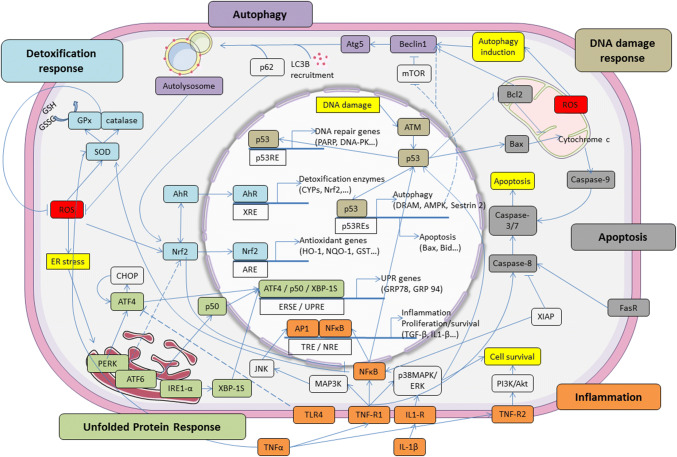Fig. 2.
Crosstalk of signaling pathways between intracellular molecules involved in the adaptive response. The figure highlights the different pathways and main factors involved in autophagy, apoptosis, inflammation, antioxidant, DNA damage, UPR and detoxification response. AhR aryl hydrocarbon receptor, Akt protein kinase B, AP1 activator protein 1, ARE antioxidant response element, ATF activating transcription factor, ATM ataxia-telangiectasia mutated, Atg autophagy-related, Bax Bcl-2–associated X, Bcl2 B-cell lymphoma 2, CHOP C/EBP homologous protein, ER endoplasmic reticulum, GPx glutathione peroxidase, IRE1 inositol requiring enzyme 1, ERSE ER stress-response element, IL interleukin, JNK c-Jun N-terminal kinases, MAPK mitogen-activated protein kinase, mTOR mechanistic target of rapamycin, LC3B light chain 3β, NF-κB nuclear factor-kappa B, NRE NF-κB response element, Nrf2 nuclear factor erythroid 2 (NFE2)-related factor 2, PERK protein kinase RNA-like ER kinase, PI3K phosphatidylinositol-4,5-bisphosphate 3-kinase, ROS reactive oxygen species, SOD superoxide dismutase, TLR toll-like receptors, TNF tumor necrosis factor, TRE 12-O-tetradecanoylphorbol-13-acetate (TPA) response element, UPR unfolded protein response, UPRE unfolded protein response element, XBP-1S X-box binding protein 1, XIAP X-linked inhibitor of apoptosis protein, XRE xenobiotic response element

